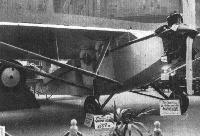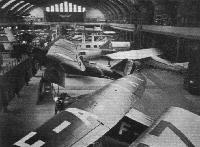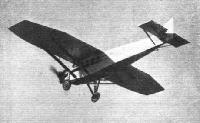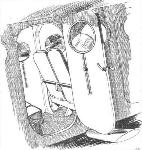
Варианты
- Farman - F.190 / F.390 - 1928 - Франция
- Farman - F.200 - 1929 - Франция
Семейство самолетов Farman F.190
F.190 стал самым популярным подкосным кабинным монопланом во Франции конца 1920-х - начала 1930-х годов, он использовался как туристский и аэротакси. Прототип F.190 выполнил первый полет в 1928 году. Закрытая кабина летчика размещена в носке крыла, за ней находится салон для четырех пассажиров. Доступ в кабину осуществляется через дверь в правом борту, расположенную сразу за креслом пилота. Шасси с широкой колеей и с хвостовой лыжей обеспечило безопасную эксплуатацию с плохо подготовленных полевых аэродромов. Хвостовое оперение типично для "Farman". Конструкция - главным образом деревянная, обшивка изготовлена из фанеры и полотна. Построены не менее ста F.190 всех вариантов, более половины от этого количества приходится на исходную модель с одним звездообразным мотором Gnome-Rhone 5Ва. Санитарный вариант F.197S (Sanitaire) позволял перевозить двух больных на носилках и одного медицинского работника. F.190 покупались частными лицами и мелкими компаниями во Франции и других странах. Основным эксплуатантом стала компания "Farman", закупившая 14 самолетов, парк "Air Union" включал семь самолетов. Среди других французских эксплуатантов можно отметить "Air Orient" и "Air Afrique". С образованием в 1933 году "Air France" к ней отошло 15 самолетов F.190. На экспорт самолеты поставлялись в компании CIDNA из Праги и LARES из Будапешта.
Базовая модель выпускалась в вариантах с моторами разного типа, что нашло отражение в обозначениях: F.192 с 230-сильным Salmson 9Ab, F.193 с 230-сильным Farman 9Еа, F.194 с мотором Hispano-Suiza 6Mb мощностью 250 л. с., F.197 с 240-сильным Lorraine 7Ме, F.198 с 250-сильным Renault 9А и F.199 с мотором Lorraine 9Na мощностью 325 л. с.
ТАКТИКО-ТЕХНИЧЕСКИЕ ХАРАКТЕРИСТИКИ
Farman F.190
Тип: пятиместный пассажирский самолет
Силовая установка: один звездообразный ПД Gnome-Rhone 5Ва мощностью 230 л. с. (172 кВт)
Летные характеристики: макс. скорость на уровне моря 185 км/ч; крейсерская скорость на оптимальной высоте 160 км/ч; практический потолок 5150 м; дальность 850 км
Масса: пустого 926 кг; максимальная взлетная 1800 кг
Размеры: размах крыла 14,40 м; длина 10,45 м; высота 3,00 м; площадь крыла 40,20 м2
Описание:
- Семейство самолетов Farman F.190
- Flight, July 1928
THE PARIS AERO SHOW 1928 - Flight, October 1928
THE BERLIN AERO SHOW 1928 - Flight, June 1929
OLYMPIA AERO SHOW 1929 - Flight, October 1933
THE FARMAN 390 - Flight, November 1934
THE FOURTEENTH PARIS AERO SHOW
Фотографии
-
Flight 1931-05 / Flight
Регистрационный номер: F-AJMV ONE TYPE IN THE TOUR OF FRANCE: The Farman 190 (230 h.p. Titan), of which two were entered.
-
Flight 1928-07 / Flight
COMMERCIAL TYPE OF AIRCRAFT AT THE PARIS SHOW: The small Farman four-passenger monoplane
-
Flight 1932-04 / Flight
The Farman 190 (240 h.p. Lorraine) on which M. D'Estailleur Chauteraine made a Flight Round Africa.
It was on a similar type of machine to this, fitted with a 300-h.p. Lorraine engine, that Goulette and Salel accomplished their flight from Paris to Cape Town in 3 3/4 days. -
Flight 1932-09 / Flight
The winner of the Cup for the second arrival was M. Seligman, who with Mme. Seligman flew over from Paris in this Farman 198 (Renault 215).
-
Flight 1932-06 / Flight
INTERESTING MACHINE AT ORLY: The "Marcel Lalouette" Farman 190 used by Goulette and Salel in their Paris-Cape flight.
-
Flight 1930-12 / Flight
ONE OF FOUR FARMANS EXHIBITED: The F.190 which flew to Indo-China in record time.
-
Мировая Авиация 127
Регистрационный номер: F-AMTO Больше чем на половине всех самолетов серии F.190 стояли моторы Titan, другие варианты встречались реже. На снимке - F.198.
-
Flight 1937-07 / Flight
Регистрационный номер: F-AMPD The scene near the Dubendorf terminal building on the opening day of the meeting. The Farman in the middle distance brought over Mlle. Deutsch de la Meurthe. On Sunday some 75,000 people were at the airport and Swissair had to turn joyriders away.
-
Flight 1929-12 / Flight
A batch of Farman F 190's, used on the French flights between France and Madagascar.
-
Flight 1934-01 / Flight
TO THE LAST DROP: Measuring the fuel left in the tanks of one of the Farman machines.
-
Flight 1932-02 / Flight
Регистрационный номер: F-ALHG MAROONED IN THE SAHARA: The three French pilots (left to right) Touge, Reginensi and Lenier and their Farman monoplane just before they started out from Le Bourget on a flight to Madagascar. As previously reported they were forced down in the Sahara and were "lost" for several days.
-
Air-Britain Archive 1983-04
Регистрационный номер: CX-ABN The unidentified Farman ambulance CX-ABH which can definitely be said to be a F.190 series machine.
-
Air-Britain Archive 1986-02
[Farman 192] The Ethiopian 'Gift Farman' refuelling on its delivery flight.
-
Air-Britain Archive 1986-02
The white Farman 192 with two of the first Ethiopian pilots, Asfaw Ali and Baharu Kaba, posing in front of it at Akaki in 1935. In the background is Fokker F.VIIb/3m CH-192 still in Swiss markings.
Другие самолёты на фотографии: Fokker F.VII / C-2 / F.XIV - Нидерланды - 1924
-
Flight 1928-10 / Flight
On the French stand: In the foreground the Nieuport-Delage commercial monoplane. In the extreme corner, a wing tip of the Potez 32. In the centre, the old Breguet "Nungesser-Coli." To the right of that the small Farman monoplane. And at the back, the Bleriot 111 and the fuselage of the Farman twin-engined machine.
Другие самолёты на фотографии: Bleriot Bleriot-111 - Франция - 1929Breguet Br.19GR Grand Raid / Br.19TF Super Bidon - Франция - 1925Farman F.180 Oiseau Bleu - Франция - 1928Nieuport-Delage Ni-D-640 - Франция - 1927Potez Potez 32 / 33 - Франция - 1928
-
Flight 1929-07 / Flight Advertisements
The Farman F.190 in flight.
-
Flight 1933-10 / Flight
Регистрационный номер: F-AMEQ THE FARMAN 390: A Cabin Machine for Pilot and Three Passengers
-
Flight 1928-07 / Flight
A peep into the little Farman four-passenger monoplane. Note the method of raising and lowering the window.
-
Flight 1929-07 / Flight
Looking into the Cabin of the Farman F.190.
-
Flight 1929-07 / Flight
Undercarriage leg attachment on the Farman F.190
- Фотографии



















